
The Top 10 Buffer Alternatives That’ll Transform Your Social Media Game in 2025
Look, I’ll be straight with you – Buffer just isn’t cutting it for a lot of us anymore. Last year alone, tons of businesses (including ours) started jumping ship to find tools that actually fit what we needed. I experienced this shift firsthand when our agency hit Buffer’s limitations while managing a client’s multi-platform campaign. The per-channel pricing became unsustainable, and we needed better analytics to prove ROI. So we went hunting for better options. And honestly? We found some pretty solid alternatives that might work way better for you too.
Table of Contents
-
TL;DR: Quick Wins for Busy Marketers
-
Comparison Table: Top 10 Buffer Alternatives at a Glance
-
What Actually Matters When Choosing a Platform
-
The Marketing Agency: Strategic Social Media Excellence
-
Sprout Social: Enterprise-Grade Powerhouse
-
Planable: Collaboration Champion
-
Hootsuite: The Veteran’s Choice
-
SocialPilot: Agency-Focused Excellence
-
Later: Visual Content Mastery
-
Agorapulse: Inbox Management King
-
CoSchedule: Marketing Calendar Integration
-
Sendible: Small Business Value Leader
-
Loomly: Content Creation Assistant
-
Zoho Social: Analytics Powerhouse
-
Notable Mentions Worth Considering
-
FAQ: Your Burning Questions Answered
-
Final Thoughts: Making the Right Choice
TL;DR: Quick Wins for Busy Marketers
Here’s the deal – I know you don’t have all day to read through every single option. So here are the key takeaways to help you quickly figure out which Buffer alternative actually makes sense for your situation.
Strategic marketing agencies: The Marketing Agency combines social media management with comprehensive digital marketing strategies for measurable ROI
Enterprise teams: Sprout Social delivers comprehensive CRM integration and advanced analytics starting at $199/month
Creative agencies: Planable excels at visual collaboration with real-time editing and client approval workflows from $33/month
Large organizations: Hootsuite provides extensive social listening and team management capabilities at $99/month
Budget-conscious agencies: SocialPilot offers white-label dashboards and bulk scheduling starting at $30/month
Visual content creators: Later specializes in Instagram and TikTok with drag-and-drop calendars from $25/month
Inbox management: Agorapulse automates message organization and team assignment starting at $79/month
Content marketers: CoSchedule combines social media with broader marketing calendars from $19/month
Small businesses: Sendible provides solid multi-account management starting at $25/month
Content optimization: Loomly offers post mockups and optimization tips from $32/month
Analytics enthusiasts: Zoho Social delivers detailed platform-specific insights starting at $10/month
These platforms each serve specific use cases, from enterprise-level social listening to simple scheduling for small businesses.
Comparison Table: Top 10 Buffer Alternatives at a Glance
|
Platform |
Best For |
Starting Price |
Key Strength |
Platform Support |
Free Trial |
|---|---|---|---|---|---|
|
The Marketing Agency |
Strategic ROI-focused campaigns |
$2,500/month |
Data-driven strategy + execution |
All major platforms |
Discovery call |
|
Sprout Social |
Enterprise teams |
$199/month |
CRM integration + analytics |
5/5 |
30 days |
|
Planable |
Creative collaboration |
$33/month |
Real-time editing |
4/5 |
Free plan |
|
Hootsuite |
Large organizations |
$99/month |
Social listening |
5/5 |
30 days |
|
SocialPilot |
Agency management |
$30/month |
White-label dashboards |
4/5 |
14 days |
|
Later |
Visual content |
$25/month |
Instagram/TikTok focus |
4/5 |
Free plan |
|
Agorapulse |
Inbox management |
$79/month |
Message automation |
4/5 |
Free plan |
|
CoSchedule |
Marketing calendars |
$19/month |
Campaign integration |
4/5 |
Free plan |
|
Sendible |
Small businesses |
$25/month |
Multi-account value |
4/5 |
14 days |
|
Loomly |
Content optimization |
$32/month |
Post guidance |
5/5 |
15 days |
|
Zoho Social |
Analytics focus |
$10/month |
Platform insights |
4/5 |
Free plan |
What Actually Matters When Choosing a Platform
Here’s the thing – there are six factors that’ll make or break your experience with any social media tool. I’ve seen too many businesses get excited about fancy features only to realize they picked the wrong platform for their actual needs.
Platform support matters because you’ll likely expand to new social networks. Tools that quickly adapt to emerging platforms save you from future headaches and migrations.
Analytics capabilities separate basic schedulers from strategic tools. You need real insights, competitor analysis, and attribution modeling to prove ROI and optimize campaigns effectively.
Team collaboration features become crucial as you scale. Approval workflows, permission levels, and client access determine whether your tool makes your life easier or more complicated.
Pricing structure impacts your budget predictability. Per-channel pricing can get expensive fast, while per-user or flat-rate models offer better scalability for growing teams.
Ease of use affects whether your team will actually adopt the platform. Complex interfaces might offer powerful features but can slow down team productivity if they require extensive training.
Advanced features determine whether your tool keeps pace with evolving marketing needs. AI-powered content suggestions, bulk scheduling, and integration capabilities make the difference between staying current and falling behind.
The Marketing Agency: Strategic Social Media Excellence
Best Known for Data-Driven Social Media Strategy
Look, here’s what sets The Marketing Agency apart from your typical “post and pray” approach. We don’t just schedule your content and call it a day – we actually dig into the data to figure out what’s working and why.
We approach social media as part of a bigger picture. Our team combines social media management with SEO, PPC, and email marketing to create campaigns that actually work together instead of fighting each other for attention.
Our proprietary market analysis systems spot opportunities that most providers miss, connecting social media activities to actual business outcomes rather than vanity metrics. This approach particularly benefits businesses seeking growth rather than just social media posting.

Features That Drive Strategic Results
Our social media management integrates with broader marketing strategies to ensure consistent messaging across all touchpoints. The data-driven approach uses behavioral insights and market intelligence to optimize content performance continuously.
Our team uses AI to crunch the numbers, but don’t worry – you’re not getting some robot managing your brand. The AI just helps us spot patterns and opportunities that we might miss otherwise. Think of it as having a really smart research assistant that never sleeps.
One thing that’s pretty cool is our LLM optimization. Basically, we make sure your content shows up when people ask ChatGPT or other AI tools about your industry. It’s like SEO, but for the AI-powered future we’re all heading toward.
And here’s something most agencies won’t tell you – we track everything back to actual dollars. Not just “engagement” or “reach,” but real ROI that you can take to your boss or investors.
Pros: Why Growth-Focused Businesses Choose The Marketing Agency
Here’s the deal – if you want someone to just post pretty pictures on Instagram, we’re probably not your guys. But if you want to actually move the needle on your business? That’s where we shine.
We’ve worked with clients who were spending thousands on social media with other agencies and had zero clue if it was working. Within 90 days, we usually have them seeing clear connections between their social efforts and their bottom line.
The reporting is refreshingly honest too. We’ll tell you straight up what’s working, what’s not, and what we think you should do about it.
Cons: Investment Considerations
Let’s be real – $2,500/month isn’t pocket change. If you’re a startup bootstrapping everything, this probably isn’t the right fit yet.
You also need to be ready to think bigger than just social media. We’re going to want to look at your whole marketing picture, which means you might discover you need to fix other stuff too.
Criteria Evaluation
Platform Support: 5/5 – We’re everywhere you need to be, and we actually understand how each platform works
Analytics: 5/5 – This is honestly where we geek out the most
Collaboration: 5/5 – You get a real human who knows your business
Pricing: 3/5 – Yeah, it’s an investment, but it’s strategic, not just tactical
Ease of Use: 5/5 – You don’t have to learn anything – we handle it all
Advanced Features: 5/5 – We’re usually ahead of the curve on new stuff
Community Reviews and Expert Recommendations
Our clients typically stick around because they can finally prove their marketing is working. One client told us, “For the first time in five years, I can walk into a board meeting and actually show how our social media drives revenue.”
The transparency thing is huge. People are tired of agencies that throw around vanity metrics and hope nobody asks hard questions.
Pricing and Where to Find It
Starting at $2,500/month for comprehensive digital marketing that includes strategic social media management.
Explore The Marketing Agency’s strategic approach
Sprout Social: Enterprise-Grade Powerhouse
Best Known for Comprehensive CRM Integration
If you’re running a bigger operation and need something that can handle enterprise-level complexity, Sprout Social is probably on your shortlist for good reason.
Think of it this way – Sprout Social is like the Swiss Army knife of social media tools, but for enterprises. It does a lot of things really well, especially when it comes to managing customer relationships through social channels.
The Smart Inbox thing is actually pretty brilliant. Ever had two people on your team respond to the same customer complaint? Yeah, it’s awkward. Sprout prevents that mess from happening.
They also bought Tagger recently, which means influencer marketing is baked right in now. No more juggling separate platforms to manage your influencer partnerships.
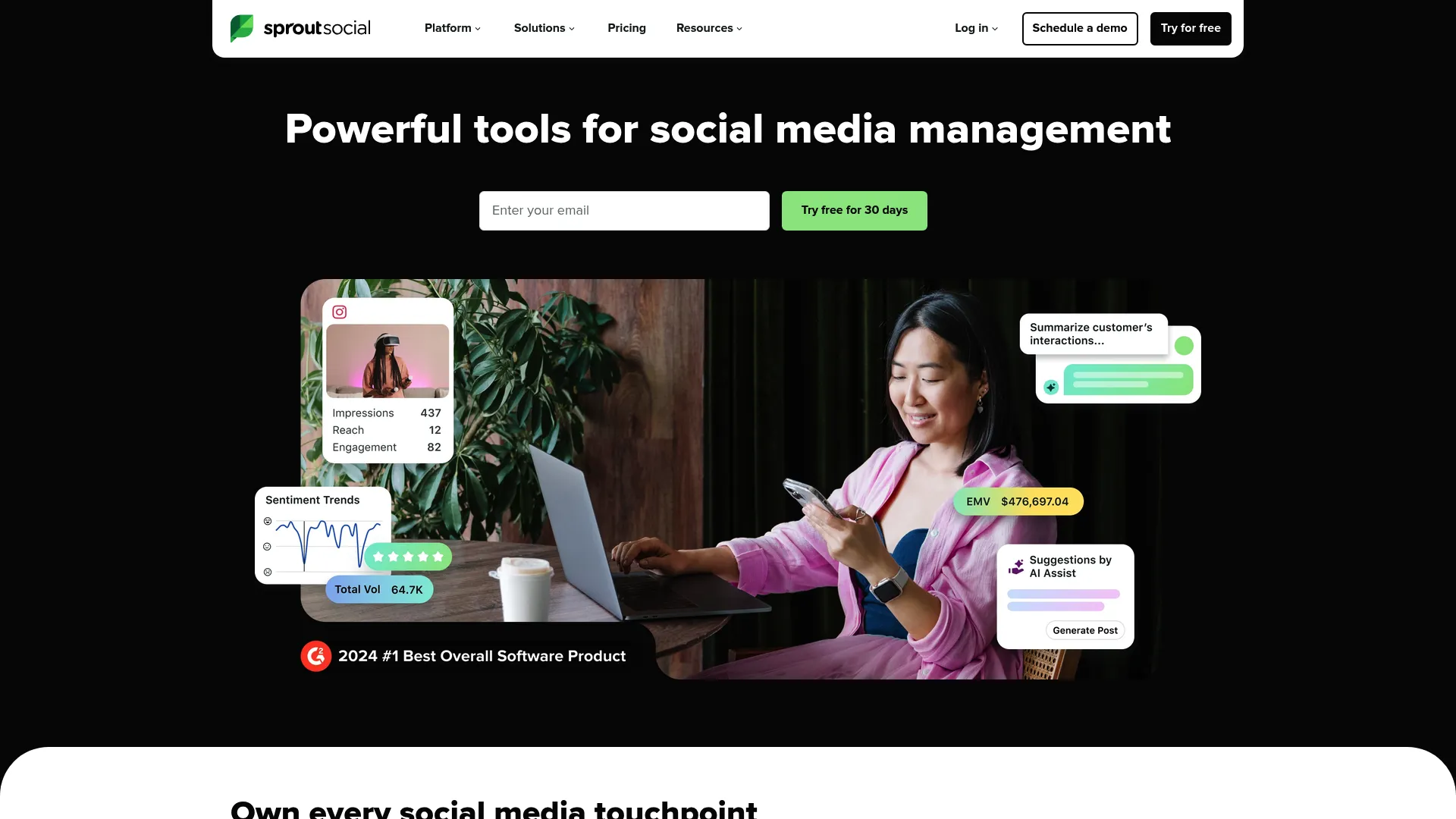
Features That Set Sprout Apart
The collision detection in their Smart Inbox is genuinely useful if you’ve got multiple people managing customer service. It’s like having a traffic cop for your social media responses.
Their analytics are presentation-ready, which is clutch if you’re constantly having to justify your social media budget to executives. You can literally screenshot their reports and put them in a board presentation without feeling embarrassed.
The employee advocacy stuff helps you turn your team into brand ambassadors without being creepy about it. People share what they want to share, but you get better reach.
Social listening is where they really flex. You can track what people are saying about you, your competitors, and your industry. It’s like having your ear to the ground 24/7.
Pros: Why Enterprises Choose Sprout
If you need to meet strict security requirements, Sprout’s got you covered. They take compliance seriously, which matters when you’re dealing with sensitive customer data.
The influencer marketing integration means one less tool to manage. For big companies juggling tons of different platforms, that’s actually a big deal.
Customer support includes dedicated account management if you’re on the enterprise plan. Having a real person who knows your account can save you hours of explaining your setup every time you need help.
Cons: Potential Drawbacks to Consider
$199/month per user adds up fast. If you’ve got a team of five, you’re looking at almost $12K per year just for social media management. That’s real money.
The learning curve is steep. All those features come with complexity, so plan on spending time training your team. It’s not something you can just jump into on Monday morning.
They require annual billing, which can be tough if you’re trying to manage cash flow or want to test it out for a few months first.
Criteria Evaluation
Platform Support: 5/5 – They cover everything you’d expect plus some newer platforms
Analytics: 5/5 – Seriously impressive reporting and competitive analysis
Collaboration: 5/5 – Built for teams with all the permissions and workflows you need
Pricing: 3/5 – You get what you pay for, but it’s definitely an investment
Ease of Use: 4/5 – Powerful but complex – plan on some training time
Advanced Features: 5/5 – Social listening, CRM integration, the works
Community Reviews and Expert Recommendations
Enterprise marketing teams love the comprehensive reporting and the fact that everything just works at scale. But smaller teams often feel like they’re paying for a Ferrari when they just need to get to the grocery store.
The general vibe is that if you can afford it and actually need all the features, it’s worth it. But if you’re just scheduling posts, it’s probably overkill.
Source: G2 Reviews and Capterra User Feedback
Pricing and Where to Find It
Starts at $199 per user per month with annual billing required. Enterprise pricing is custom.
Explore Sprout Social’s pricing options
Planable: Collaboration Champion
Best Known for Real-Time Team Editing
If you’ve ever had five people editing the same social media post and nobody knows which version is the “final” one, Planable is going to feel like a miracle.
It’s basically Google Docs for social media. Multiple people can work on the same post at the same time, and you can see everyone’s changes in real-time. No more “Can you send me the latest version?” emails.
The visual calendar is pretty slick too – you can see exactly how your posts will look on each platform before you publish. No more surprises when your carefully crafted Instagram post looks weird because you forgot about the character limit.
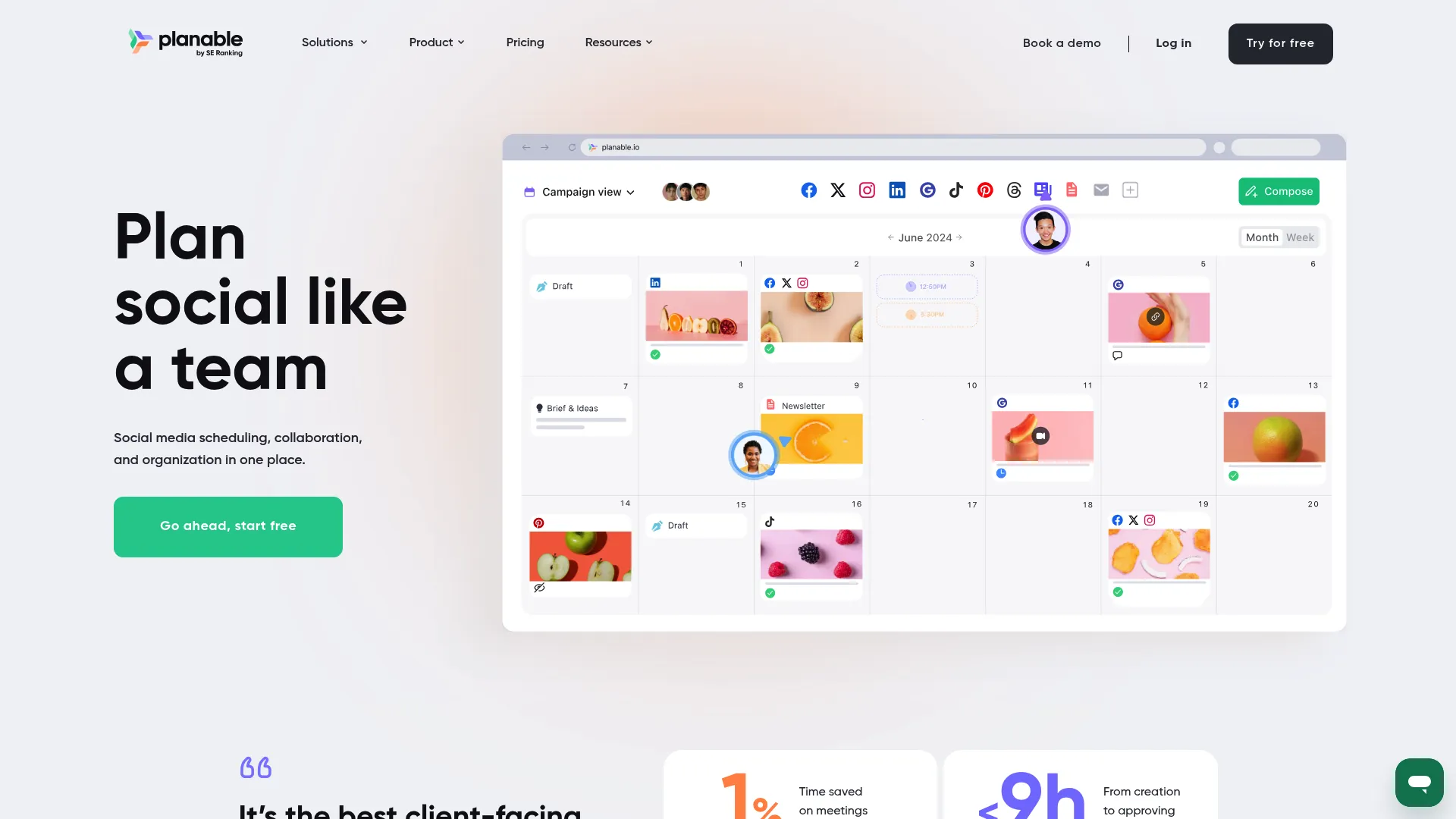
Features That Streamline Collaboration
The approval workflow is super flexible. You can set it up so nothing goes out without approval, or make it optional, or even have multiple levels of approval for different types of content. Whatever makes sense for your team.
Clients can review and approve posts without needing to create accounts or learn a new platform. They just click a link, see how the post will look, and give you a thumbs up or down. It’s brilliant in its simplicity.
The campaign organization keeps related posts grouped together, which is clutch when you’re managing seasonal campaigns or product launches across multiple platforms.
Internal notes let your team discuss strategy and execution details privately while keeping client-facing comments clean and professional.
Pros: Why Agencies Love Planable
The free plan lets you test it out with up to 50 posts, which is generous enough to actually see if it works for your workflow.
The visual previews are spot-on. What you see is really what you get when the post goes live, which eliminates a lot of “oops” moments.
Real-time collaboration means faster turnaround times. No more waiting for someone to finish their edits before you can make yours.
Cons: Areas for Improvement
Social listening isn’t really a thing here, so you’ll need another tool if you want to monitor mentions and conversations.
Analytics cost extra, which can add up if you need detailed reporting. The base platform is focused on creation and collaboration, not measurement.
No social inbox means you’re handling customer responses through the native platforms or another tool.
Criteria Evaluation
Platform Support: 4/5 – Covers the major platforms with strong visual content support
Analytics: 3/5 – Basic stuff included, better analytics available as add-ons
Collaboration: 5/5 – This is literally what they’re best at
Pricing: 4/5 – Reasonable pricing with a solid free tier
Ease of Use: 5/5 – Super intuitive, your team will get it immediately
Advanced Features: 4/5 – Great approval workflows and content previews
Community Reviews and Expert Recommendations
Agencies consistently say it improves their client relationships because the approval process is so smooth. Clients love being able to see exactly how posts will look without having to log into multiple platforms.
Freelancers appreciate how professional it makes them look, even if they’re a one-person operation.
Source: Product Hunt Reviews and Agency Community Forums
Pricing and Where to Find It
Free plan for up to 50 posts, paid plans start at $33 per workspace. The workspace model means unlimited users within each workspace.
Check out Planable’s collaboration features
Hootsuite: The Veteran’s Choice
Best Known for Enterprise Team Management
Hootsuite’s been around forever in social media years, and it shows – both in good ways and not-so-good ways.
On the plus side, they’ve had time to build out enterprise features that actually work at scale. If you’re managing social media for a Fortune 500 company, Hootsuite probably has the features you need.
The downside? Sometimes it feels like they’ve added so many features over the years that the interface can be overwhelming. It’s powerful, but it’s not exactly what you’d call “user-friendly.”
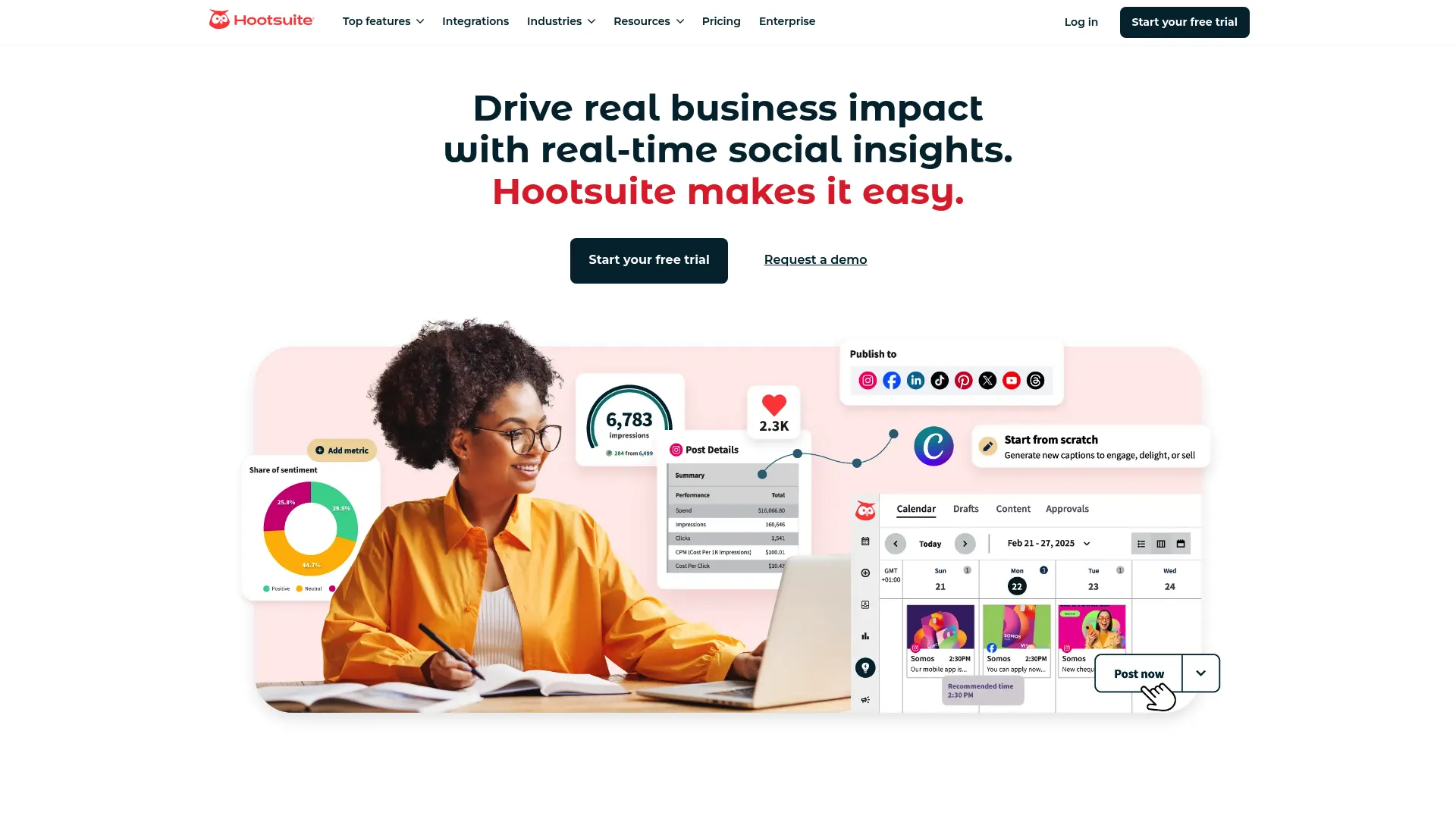
Features Built for Scale
The bulk scheduling is legitimately impressive if you’re dealing with hundreds of posts. You can upload a CSV file and schedule everything at once across multiple accounts.
Social listening got a major upgrade when they acquired Talkwalker. Now you can monitor brand mentions, track sentiment, and keep tabs on competitors all in one place.
Employee advocacy tools help you amplify your content through your team’s personal networks. It’s opt-in for employees, so it doesn’t feel creepy, but it can significantly expand your reach.
Team management includes productivity reports that show individual and team performance metrics. These insights help optimize resource allocation and identify training needs.
Pros: Why Large Organizations Choose Hootsuite
It integrates with pretty much everything. If you’re using other marketing tools, there’s probably a Hootsuite integration for it.
The social listening capabilities are enterprise-grade. You can set up complex monitoring queries and get alerts when important conversations happen.
It’s built to handle massive scale. If you’re publishing hundreds of posts per week across dozens of accounts, Hootsuite won’t break a sweat.
Cons: Considerations Before Committing
$99/month per user is steep, especially when you multiply it across a team. You’re looking at serious money for a full marketing department.
The interface is… a lot. New users often feel overwhelmed by all the options and features. Plan on significant training time.
The learning curve can delay getting value from the platform. It might take weeks or months before your team is really productive with it.
Criteria Evaluation
Platform Support: 5/5 – Comprehensive platform support including newer networks
Analytics: 5/5 – Advanced analytics plus social listening capabilities
Collaboration: 5/5 – Built for large teams with complex organizational structures
Pricing: 2/5 – Expensive, especially for smaller teams
Ease of Use: 3/5 – Powerful but complex – definitely not plug-and-play
Advanced Features: 5/5 – Social listening, bulk scheduling, extensive integrations
Community Reviews and Expert Recommendations
Enterprise teams generally love the feature set and reliability. It handles high-volume campaigns without choking, which is crucial for big organizations.
Smaller teams often feel like they’re paying for a lot of features they’ll never use. The consensus seems to be that it’s worth it if you need the advanced features, but overkill if you don’t.
Source: TrustRadius Enterprise Reviews and LinkedIn Marketing Communities
Pricing and Where to Find It
Starts at $99 per user per month with annual billing required. Enterprise plans are custom-priced.
Explore Hootsuite’s enterprise features
SocialPilot: Agency-Focused Excellence
Best Known for White-Label Client Dashboards
If you’re running an agency and tired of tools that don’t understand how you actually work with clients, SocialPilot gets it.
They built their platform specifically thinking about agency workflows. The white-label dashboards let you present analytics and content calendars under your own branding, which makes you look more professional and established – even if you’re a one-person shop.
The approval process is dead simple too. Clients don’t need to create accounts or learn new interfaces. They just click a link, see how the post will look, and approve or request changes. It’s that easy.

Features Designed for Agencies
White-label dashboards display your agency’s branding throughout the client experience. This professional presentation helps justify premium pricing and builds client confidence.
The approval process uses shareable links that display content previews. Clients can approve or request changes without accessing the platform directly, which reduces training headaches and security concerns.
Automated performance reports deliver insights to clients on predetermined schedules. This keeps clients informed without you having to remember to send reports every month.
The AI assistant helps generate content ideas and variations when you’re stretched thin on creative resources. It gives you starting points that you can refine and personalize.
Pros: Why Agencies Choose SocialPilot
At $30/month, it’s accessible for growing agencies and freelancers. This competitive rate includes features that other platforms charge premium prices for.
No client signup requirements eliminate onboarding friction. Clients can participate in the approval process without creating accounts or remembering passwords.
Strong bulk scheduling capabilities handle large content volumes efficiently. You can prepare months of content and schedule it across multiple client accounts at once.
Cons: Potential Limitations
Limited advanced analytics in lower pricing tiers might require upgrades for comprehensive reporting. If you need detailed insights, you might face additional costs.
Some features are restricted to higher-priced plans, which can increase costs as you grow. The tiered structure might create upgrade pressure as your needs expand.
Fewer integrations compared to enterprise solutions might require additional tools for complete workflows. If you have a complex tech stack, you might need supplementary platforms.
Criteria Evaluation
Platform Support: 4/5 – Good coverage of major platforms with bulk scheduling capabilities
Analytics: 4/5 – Solid analytics with white-label reporting options
Collaboration: 5/5 – Agency-focused with client dashboards and approval workflows
Pricing: 4/5 – Competitive pricing specifically designed for agency needs
Ease of Use: 4/5 – User-friendly interface designed for agency workflows
Advanced Features: 4/5 – AI assistant, bulk scheduling, and white-label options
Community Reviews and Expert Recommendations
Agency owners consistently praise SocialPilot’s client management features and competitive pricing. The white-label capabilities help smaller agencies compete with larger firms on presentation quality.
Freelancers appreciate the low barrier to entry and professional features that enhance client relationships. The platform helps solo practitioners appear more established and organized.
Source: Agency Facebook Groups and Freelancer Communities
Pricing and Where to Find It
Starts at $30/month for agencies, with plans scaling based on client and account needs. The pricing structure specifically addresses agency economics.
Discover SocialPilot’s agency features
Later: Visual Content Mastery
Best Known for Instagram and TikTok Specialization
If your brand lives and breathes visual content, Later just makes sense. They built their whole platform around the idea that Instagram and TikTok need different treatment than text-heavy platforms like LinkedIn or Twitter.
The drag-and-drop visual calendar shows exactly how your feed will look, which is huge for maintaining that aesthetic consistency that visual platforms demand. You can see how individual posts work together to tell your brand story visually.
Their link-in-bio tools are pretty clever too – they help you maximize traffic from platforms that limit clickable links, which can be a real pain point for visual brands.
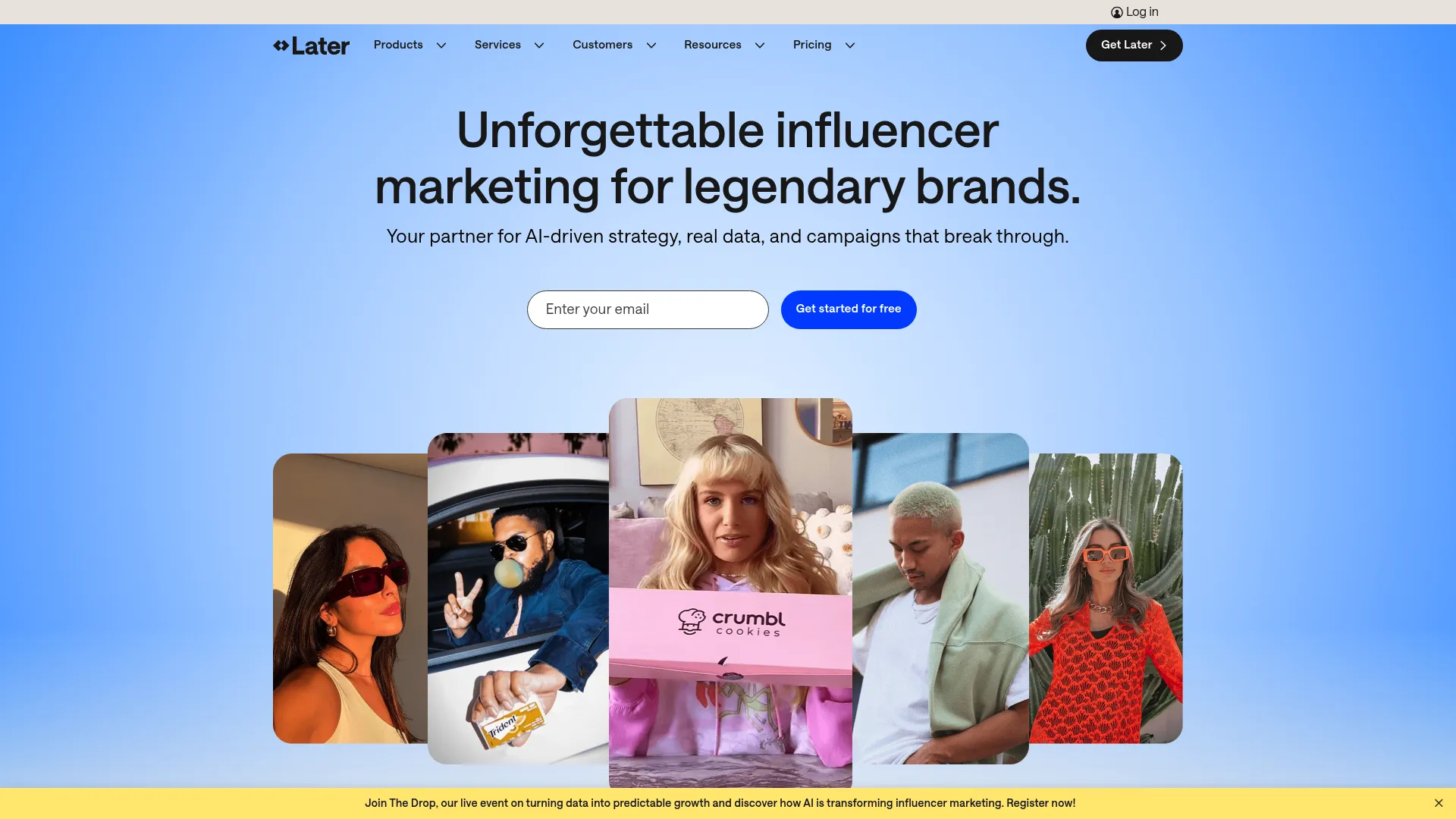
Features Tailored for Visual Creators
The drag-and-drop visual calendar lets you arrange posts to create cohesive feed aesthetics. You can see how everything flows together before anything goes live.
Media library organization keeps visual assets searchable and accessible. Your team can quickly find brand-approved images, videos, and graphics without digging through folders.
Link-in-bio optimization tools help drive traffic from Instagram stories and posts. The feature creates landing pages that showcase multiple links in an attractive, mobile-friendly format.
Hashtag suggestions analyze your content and recommend relevant tags to improve discoverability. The tool considers trending hashtags and your audience’s interests.
Pros: Visual Content Advantages
Excellent Instagram and TikTok analytics provide insights specific to visual content performance. You can track which visual elements drive the most engagement and adjust accordingly.
User-friendly visual interface requires minimal training for creative teams. Designers and content creators can start using it immediately without extensive onboarding.
Strong link-in-bio functionality maximizes traffic potential from platforms with limited linking options. This feature often becomes a significant traffic driver for visual brands.
Cons: Platform Limitations
Limited features for non-visual platforms reduce its value for comprehensive social strategies. If you’re active on LinkedIn or Twitter, you’ll need additional tools.
Social inbox only works for Instagram and TikTok, so you’ll need separate tools for customer service on other platforms. This fragments your communication management.
Higher pricing compared to some alternatives might not justify the cost for brands not focused on visual content. The specialization comes at a premium.
Criteria Evaluation
Platform Support: 4/5 – Strong support for visual platforms with limited text-based platform features
Analytics: 3/5 – Good analytics for visual content with TikTok specialization
Collaboration: 3/5 – Basic collaboration features focused on visual content workflows
Pricing: 3/5 – Mid-range pricing that reflects visual content specialization
Ease of Use: 5/5 – Excellent visual interface with intuitive drag-and-drop functionality
Advanced Features: 4/5 – Visual content management and link-in-bio optimization tools
Community Reviews and Expert Recommendations
Visual content creators and Instagram-focused brands consistently recommend Later for its aesthetic planning capabilities. Fashion, food, and lifestyle brands particularly appreciate the visual calendar feature.
However, B2B companies and multi-platform marketers often find the visual focus limiting. The platform works best for brands where visual storytelling drives engagement.
Source: Instagram Creator Communities and Visual Marketing Forums
Pricing and Where to Find It
Starts at $25/month with plans scaling based on features and account limits. Visual content creators often find the investment worthwhile for the specialized features.
Explore Later’s visual content tools
Agorapulse: Inbox Management King
Best Known for Automated Message Organization
If you’re drowning in social media messages, comments, and DMs across multiple platforms, Agorapulse is going to save your sanity.
Their Inbox Assistant automatically sorts through all the chaos and organizes everything by type – questions, complaints, compliments, spam. It even assigns messages to the right team members based on rules you set up.
This is particularly clutch if you’re handling high message volumes. Instead of manually sorting through hundreds of comments and messages every day, your team can focus on actually responding to people.

Features That Organize Chaos
Inbox Assistant automatically categorizes incoming messages as questions, complaints, compliments, or spam. This intelligent sorting helps teams prioritize responses and maintain appropriate tone.
Advanced inbox filters create custom views based on platform, message type, or team member assignment. These filters help managers monitor team performance and identify bottlenecks.
Team performance reports track response times, message volume, and resolution rates for each team member. These insights help optimize staffing and identify training opportunities.
Google My Business review management centralizes review responses alongside social media messages. This integration streamlines reputation management across multiple touchpoints.
Pros: Customer Service Excellence
Exceptional social media inbox management eliminates the chaos of multi-platform customer service. Teams can handle higher message volumes without sacrificing response quality.
Automated message organization saves hours of manual sorting and assignment. The system learns from your preferences and becomes more accurate over time.
Strong team performance tracking helps managers optimize customer service operations. The insights support data-driven decisions about staffing and training.
Cons: Feature Limitations
Higher pricing for full features might strain budgets for smaller businesses. The comprehensive inbox management comes at a premium cost.
Limited Pinterest support reduces value for brands active on that platform. Visual content creators might need supplementary tools.
Some collaboration features only appear in higher pricing tiers, potentially increasing costs as teams grow. The tiered structure can create upgrade pressure.
Criteria Evaluation
Platform Support: 4/5 – Good platform coverage with strong inbox management focus
Analytics: 4/5 – Comprehensive analytics with team performance reports
Collaboration: 5/5 – Excellent inbox management and team collaboration tools
Pricing: 3/5 – Higher pricing justified by specialized inbox features
Ease of Use: 4/5 – User-friendly with intuitive inbox management interface
Advanced Features: 5/5 – Automated inbox assistant and advanced filtering capabilities
Community Reviews and Expert Recommendations
Customer service managers praise Agorapulse’s ability to transform social media support operations. The automated organization significantly reduces response times and improves customer satisfaction.
Small businesses appreciate the free plan availability, though they often need to upgrade for full inbox management features. The platform scales well with growing customer service needs.
Source: Customer Service Software Reviews and Social Media Management Communities
Pricing and Where to Find It
Offers a free plan with limited features, while paid plans start at $79 per user per month. The pricing reflects the specialized inbox management capabilities.
Try Agorapulse’s inbox management features
CoSchedule: Marketing Calendar Integration
Best Known for Unified Marketing Planning
Here’s the thing about CoSchedule – it recognizes that social media doesn’t exist in a vacuum. It’s part of your bigger marketing picture, and their unified marketing calendar shows how social posts relate to email campaigns, blog publications, and promotional activities.
This holistic approach helps marketing teams maintain consistency across channels and avoid those awkward moments when your email campaign contradicts your social posts. The platform serves as a central command center for all your marketing activities.
If you’re managing content marketing beyond just social media, CoSchedule might be exactly what you need.

Features Beyond Social Media
Unified marketing calendar displays all marketing activities in a single view. Teams can see how social posts align with email campaigns, blog publications, and promotional events.
AI-powered writing assistant helps generate content ideas and optimize headlines. The tool provides data-driven suggestions for improving engagement and click-through rates.
Email subject line tester and headline generator use data from millions of campaigns to predict performance. These tools help optimize content before publication.
WordPress integration automatically pulls blog posts into the marketing calendar. This connection ensures social promotion aligns with content publication schedules.
Pros: Comprehensive Marketing Management
Combines social media with broader content marketing strategy, eliminating the need for separate planning tools. This integration improves campaign coordination and consistency.
Strong project management capabilities help teams track campaign progress and deadlines. The task assignment features ensure accountability and timely execution.
AI-powered content creation tools provide valuable starting points when creative resources are limited. The suggestions help overcome writer’s block and improve content quality.
Cons: Scope Considerations
Twitter integration only appears in paid plans, limiting free tier functionality. Social media-focused teams might need to upgrade immediately.
More focused on content marketing than pure social media management. Teams needing advanced social features might find gaps in functionality.
Might be overkill for social-media-only needs, potentially complicating workflows for teams not managing broader marketing campaigns. The comprehensive approach isn’t always necessary.
Criteria Evaluation
Platform Support: 4/5 – Good social platform support with content marketing focus
Analytics: 4/5 – Strong analytics with team performance tracking capabilities
Collaboration: 5/5 – Excellent project management and team collaboration features
Pricing: 4/5 – Reasonable pricing for comprehensive marketing calendar features
Ease of Use: 4/5 – Intuitive calendar-based interface with learning curve for advanced features
Advanced Features: 5/5 – Marketing calendar, task management, and AI writing assistant
Community Reviews and Expert Recommendations
Content marketing managers consistently praise CoSchedule’s ability to coordinate complex campaigns across multiple channels. The unified calendar view significantly improves campaign planning and execution.
However, social media specialists sometimes find the broader marketing focus dilutes social-specific features. The platform works best for integrated marketing teams rather than social-only operations.
Source: Content Marketing Institute Reviews and Marketing Manager Communities
Pricing and Where to Find It
Offers a free plan with basic features, while paid plans start at $19 per user per month. The pricing reflects the comprehensive marketing calendar functionality.
Discover CoSchedule’s marketing calendar
Sendible: Small Business Value Leader
Best Known for Multi-Account Management Value
Sendible gets that not every business has enterprise budgets or needs enterprise complexity. They focus on providing essential social media management features without the premium pricing that makes other platforms inaccessible.
Their approach prioritizes value and functionality over advanced features that many small businesses don’t actually need. You get professional-grade features without paying for enterprise complexity you’ll never use.

Features That Deliver Value
Comment monitoring across major platforms helps maintain engagement without constantly checking individual platform notifications. The centralized approach saves time and ensures consistent response quality.
Client dashboards with custom branding help agencies present professional reports without additional design work. The white-label options enhance credibility with clients.
Bulk importing capabilities handle large content volumes efficiently. Teams can prepare extensive content libraries and schedule them across multiple accounts simultaneously.
Centralized content library keeps approved assets organized and accessible. Team members can quickly find brand-compliant images, videos, and copy without searching through folders.
Pros: Small Business Advantages
Good value for managing multiple social accounts without per-channel pricing penalties. The structure makes it affordable to expand your social media presence across platforms.
Better pricing structure than per-channel competitors, providing predictable costs as businesses grow. This transparency helps with budget planning and scaling decisions.
Solid collaboration features support team growth without requiring immediate platform changes. Small businesses can start solo and add team members as needed.
Cons: Feature Limitations
No Pinterest support limits value for visual content creators and e-commerce businesses. Brands active on Pinterest need supplementary tools or alternative platforms.
Limited 24/7 support options might frustrate businesses operating across time zones. The support structure works better for standard business hours operations.
Advanced features only appear in higher pricing tiers, potentially increasing costs as businesses grow. The tiered structure can create upgrade pressure over time.
Criteria Evaluation
Platform Support: 4/5 – Good platform coverage excluding Pinterest
Analytics: 4/5 – Solid analytics with custom reporting in higher tiers
Collaboration: 4/5 – Good collaboration tools with client dashboard capabilities
Pricing: 4/5 – Competitive pricing structure designed for small business growth
Ease of Use: 4/5 – User-friendly interface with straightforward setup process
Advanced Features: 3/5 – Basic AI features with room for improvement
Community Reviews and Expert Recommendations
Small business owners appreciate Sendible’s straightforward approach and transparent pricing. The platform provides necessary features without overwhelming complexity or premium costs.
Agencies managing multiple small clients find the value proposition compelling. The white-label features help maintain professional appearance while controlling costs.
Source: Small Business Software Reviews and Agency Owner Forums
Pricing and Where to Find It
Starts at $25/month for 6 social profiles with a 14-day free trial available. The pricing structure scales reasonably with business growth.
Explore Sendible’s small business features
Loomly: Content Creation Assistant
Best Known for Post Optimization Guidance
If you’ve ever stared at a blank post wondering what to write or how to optimize it, Loomly is like having a content coach sitting next to you.
They provide intelligent content creation assistance throughout the posting process. Their post mockups show exactly how content will appear across different platforms, while optimization tips help improve engagement potential before you hit publish.
This educational approach is particularly helpful for smaller teams or businesses without dedicated social media expertise. The platform teaches best practices while managing content.
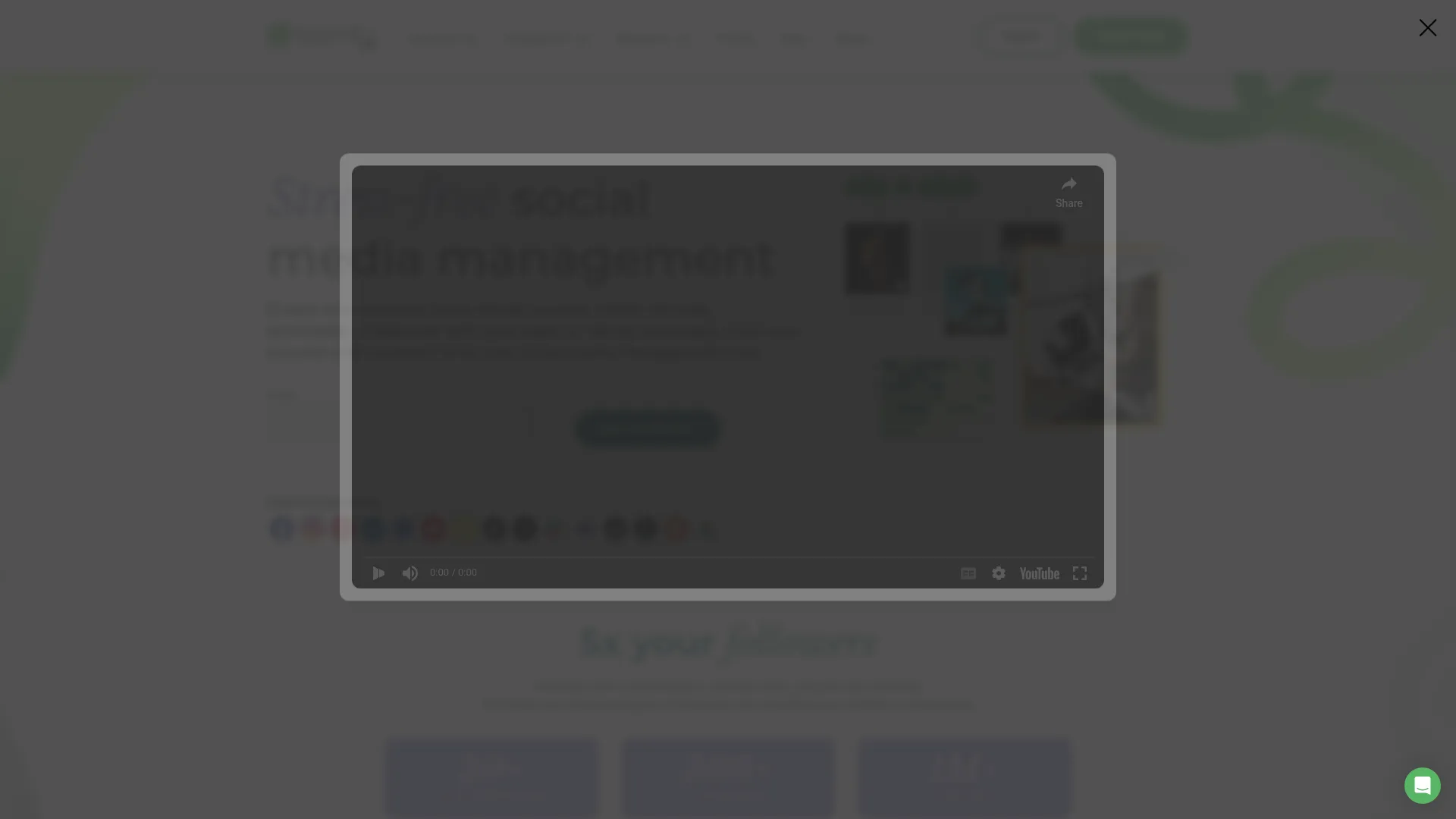
Features That Improve Content Quality
Post mockups display content exactly as it will appear on each platform, including character limits and image dimensions. This preview capability reduces formatting surprises and ensures professional presentation.
Automatic post optimization tips suggest improvements based on platform best practices and current trends. The recommendations help teams create more engaging content without extensive research.
Audience targeting for Facebook and LinkedIn helps optimize content reach and engagement. The platform suggests targeting parameters based on content type and business objectives.
Automated report scheduling delivers performance insights to stakeholders on predetermined schedules. This proactive communication demonstrates value and maintains stakeholder engagement.
Pros: Content Creation Support
Excellent content creation assistance helps teams produce higher-quality posts. The optimization tips and mockups significantly improve content performance over time.
Strong platform support includes newer networks, ensuring businesses can expand their social presence as platforms emerge. This future-proofing protects against platform shifts.
Good value for teams since plans include multiple users without per-seat pricing penalties. This structure makes it affordable for growing teams to collaborate effectively.
Cons: Process Considerations
No free version available limits trial opportunities for budget-conscious businesses. Teams need to commit to paid plans without extensive testing periods.
Slightly cumbersome post creation process might slow down high-volume content production. The optimization guidance adds steps that some teams might find unnecessary.
Higher pricing compared to some alternatives might not justify the cost for teams not needing content creation assistance. The specialized features come at a premium.
Criteria Evaluation
Platform Support: 5/5 – Extensive platform support including newer networks
Analytics: 4/5 – Good analytics with automated report scheduling capabilities
Collaboration: 4/5 – Solid collaboration with approval workflows and team comments
Pricing: 3/5 – Higher pricing justified by content creation assistance features
Ease of Use: 4/5 – User-friendly with helpful optimization tips throughout the interface
Advanced Features: 4/5 – Post mockups, optimization tips, and audience targeting capabilities
Community Reviews and Expert Recommendations
Content creators and small marketing teams praise Loomly’s educational approach and content improvement suggestions. The platform helps less experienced teams produce professional-quality content.
However, high-volume content producers sometimes find the optimization process slows down their workflows. The platform works best for teams prioritizing quality over quantity.
Source: Content Creator Communities and Small Business Marketing Forums
Pricing and Where to Find It
Starts at $32/month for 2 users and 10 social accounts. The pricing includes content creation assistance and optimization features.
Try Loomly’s content optimization tools
Zoho Social: Analytics Powerhouse
Best Known for Platform-Specific Insights
If you’re a data nerd who wants to understand exactly what’s happening with your social media performance, Zoho Social is going to make you very happy.
They leverage Zoho’s data analytics expertise to provide exceptionally detailed social media insights. Their platform-specific analytics reveal nuances that generic reporting often misses, helping you optimize your strategy for each social network’s unique characteristics.
The integration with Zoho’s broader business ecosystem creates opportunities for comprehensive customer journey tracking that standalone tools can’t match.

Features That Reveal Deep Insights
Detailed analytics for YouTube, TikTok, and Pinterest provide platform-specific metrics that help optimize content for each network’s unique algorithm and audience behavior patterns.
Platform-specific insights include LinkedIn follower demographics, Instagram story completion rates, and Facebook post reach patterns. These granular details inform strategic decisions.
Social listening and monitoring capabilities track brand mentions, competitor activities, and industry conversations. The sentiment analysis helps understand public perception trends.
Integration with Zoho CRM and Desk connects social media activities to customer support and sales outcomes. This connection provides attribution data that justifies social media investment.
Pros: Analytics Excellence
Excellent analytics and reporting capabilities provide insights that inform strategic decisions rather than just tracking vanity metrics. The depth of analysis supports data-driven optimization.
Strong integration with Zoho ecosystem benefits businesses already using Zoho products. The unified data view improves customer understanding and campaign coordination.
Good value for businesses needing comprehensive analytics without enterprise pricing. The platform delivers advanced insights at accessible price points.
Cons: Integration Dependencies
Higher pricing for entry-level plans compared to basic social media schedulers might not suit businesses needing simple posting capabilities. The analytics focus commands premium pricing.
Limited manual video editing tools require external software for content creation. Teams producing video content need supplementary editing platforms.
Best value emerges only for existing Zoho users, potentially limiting appeal for businesses using different software ecosystems. Standalone users miss integration benefits.
Criteria Evaluation
Platform Support: 4/5 – Good platform coverage with strong YouTube and TikTok support
Analytics: 5/5 – Excellent platform-specific analytics and detailed reporting capabilities
Collaboration: 4/5 – Good collaboration with Zoho ecosystem integration benefits
Pricing: 3/5 – Higher pricing offset by comprehensive analytics features
Ease of Use: 4/5 – User-friendly with familiar Zoho interface design
Advanced Features: 4/5 – Strong analytics, social listening, and Zoho integrations
Community Reviews and Expert Recommendations
Data-driven marketers consistently highlight Zoho Social’s superior analytics capabilities and actionable insights. The platform helps teams move beyond vanity metrics to meaningful performance indicators.
Existing Zoho customers particularly appreciate the seamless integration and unified customer data view. However, standalone users sometimes question the value proposition without ecosystem benefits.
Source: Zoho User Communities and Analytics-Focused Marketing Groups
Pricing and Where to Find It
Offers a free version with basic features, while paid plans start at $10/month. The analytics capabilities justify the investment for data-focused teams.
Discover Zoho Social’s analytics features
Notable Mentions Worth Considering
Vista Social: Enterprise Features at Accessible Prices
Vista Social consolidates scheduling, unified inbox, analytics, and review management into a comprehensive platform without enterprise-level pricing. Their support for emerging platforms positions growing teams for future expansion.
Explore Vista Social’s comprehensive features
MeetEdgar: Content Recycling Automation
Built specifically for content recycling, MeetEdgar creates categorized libraries of evergreen content and automatically republishes on recurring schedules. The AI assistant generates content variations to maintain freshness while maximizing content investment.
Check out MeetEdgar’s recycling capabilities
Metricool: Unified Analytics Dashboard
This affordable solution combines social media, website, and advertising analytics in a single dashboard. Features include drag-and-drop scheduling, AI content assistance, and integrations with Canva and Adobe Express for streamlined content creation.
Try Metricool’s unified analytics
Tailwind: Pinterest and Instagram Optimization
Specialized for Pinterest and Instagram success, Tailwind offers content scheduling, hashtag recommendations, and SmartLoop for automated evergreen content resharing. Recent email marketing additions create value for visual content creators expanding their marketing reach.
Discover Tailwind’s visual platform expertise
FAQ: Your Burning Questions Answered
Which Buffer Alternative Offers the Best Value for Small Businesses?
Small businesses should prioritize platforms that offer essential features without enterprise complexity, focusing on transparent pricing and scalability that matches their growth trajectory.
Sendible and SocialPilot emerge as top value choices for small businesses. Sendible’s $25/month starting price includes six social profiles with solid collaboration features, while SocialPilot’s agency-focused approach at $30/month provides white-label capabilities that help small businesses appear more professional.
Consider your growth plans when evaluating value. Per-channel pricing models become expensive quickly, while per-user or flat-rate structures provide better predictability as you expand your social presence.
What’s the Best Buffer Alternative for Visual Content Creators?
Visual content creators need platforms that understand the unique requirements of image and video-heavy social networks, particularly Instagram, TikTok, and Pinterest.
Later dominates the visual content space with its drag-and-drop calendar that shows exactly how your feed will look. The platform’s Instagram and TikTok specialization includes features that generic platforms often miss.
Tailwind serves as a strong alternative for Pinterest-focused creators, offering specialized scheduling and SmartLoop features for evergreen content recycling. The platform understands Pinterest’s unique algorithm and timing requirements.
Which Platform Provides the Most Comprehensive Analytics?
Advanced analytics separate strategic social media management from basic scheduling, requiring platforms that provide actionable insights rather than vanity metrics.
Sprout Social and Zoho Social lead in analytics capabilities, though they serve different market segments. Sprout Social provides enterprise-grade insights with competitor benchmarking and ROI tracking, while Zoho Social offers detailed platform-specific analytics at more accessible pricing.
Hootsuite’s social listening capabilities (through Talkwalker acquisition) provide comprehensive brand monitoring and sentiment analysis. This feature set particularly benefits larger organizations needing market intelligence alongside performance metrics.
How Do These Alternatives Handle Team Collaboration?
Team collaboration features determine whether social media tools enhance or hinder productivity, particularly for agencies and larger marketing teams managing complex approval workflows.
Planable revolutionizes collaboration with real-time editing capabilities that eliminate version control issues. Multiple team members can edit posts simultaneously while clients provide feedback through shareable links without needing platform access.
Agorapulse excels at inbox management collaboration, automatically organizing and assigning customer messages to appropriate team members. This automation particularly benefits businesses handling high volumes of customer interactions across multiple platforms.
What Should I Consider When Migrating from Buffer?
Successful platform migration requires careful planning around data export, team training, and workflow adjustments to minimize disruption while maximizing new platform benefits.
Start by auditing your current Buffer usage to identify which features you actually need versus nice-to-have capabilities. Many businesses discover they’re paying for features they rarely use while missing functionality that could improve their results. Reading our comprehensive Buffer review can help identify specific pain points.
Plan for team training and workflow adjustments. Even user-friendly platforms require adaptation time, and rushing implementation often leads to decreased productivity during transition periods. Consider running parallel systems briefly to ensure smooth migration.
Export your historical data and content libraries before canceling Buffer. Most alternatives can import this information, but having backups ensures you don’t lose valuable performance insights or approved content assets.
Final Thoughts: Making the Right Choice
Selecting the optimal Buffer alternative requires balancing current needs with future growth plans while considering team capabilities and budget constraints that align with your business objectives.
The social media management landscape offers solutions for every business size and need. Your choice shouldn’t just address current limitations with Buffer—it should position your team for future growth and evolving social media requirements.
Consider these key decision factors:
Budget predictability: Choose pricing models that scale with your growth without creating financial surprises
Team capabilities: Match platform complexity to your team’s expertise and training capacity
Integration requirements: Ensure your chosen platform connects with existing marketing tools and workflows
Growth trajectory: Select platforms that support your expansion plans across new social networks and team members
Specialization needs: Prioritize platforms that excel in your primary use cases rather than trying to be everything to everyone
At The Marketing Agency, we’ve helped dozens of businesses navigate these platform transitions while maintaining campaign momentum. Our experience reveals that the most successful migrations happen when businesses align platform capabilities with strategic objectives rather than simply seeking feature parity with their current tool. For enterprise teams, our detailed Hootsuite analysis offers additional insights, while visual creators should explore our Later platform review.
We understand that social media management platforms are just one component of comprehensive digital marketing success. The right platform should integrate seamlessly with your SEO efforts, PPC campaigns, email marketing, and broader customer acquisition strategies.
If you’re ready to move beyond basic social media scheduling into strategic, data-driven social media marketing that delivers measurable ROI, we’d love to discuss how we can support your growth objectives. Our scientific approach to market analysis helps identify opportunities that most agencies miss when connecting social media performance to business outcomes.
Ready to transform your social media strategy? Contact The Marketing Agency today to discover how the right platform choice, combined with strategic expertise, can accelerate your business growth.





